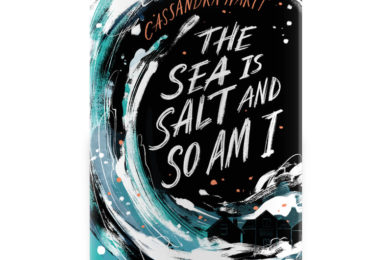Cassandra Hartt, The Sea is Salt and So Am I, hardcover $18.99, ISBN: 987-1-250-61924-2
The Sea is Salt and So Am I, a novel by Cassandra Hartt, is a thoughtful and accurate portrayal of depression, coming-of-age, relationships, and heartbreak. Any teenager can see themselves in the town of West Finch — somewhere quiet and close to the water, where everyone knows their neighbours and their vices, soon to be washed away with the town itself as the earth erodes into the sea. Twin brothers Tommy Macqueen, who struggles with depression, and Ellis Macqueen, who bears the emotional burden of his brother’s depression, along with teenage activist Harlow Prout, who fears change and losing her best friend Ellis, are accessible and multidimensional narrators whose lives and issues create a space for each and every reader to feel heard in one way or another. But just because the stories told through these characters are accurate, doesn’t mean they are handled in the best way.
The town of West Finch isn’t so much a setting, as a character itself. West Finch is sinking into the ocean little by little — a metaphor for everything wrong with the three narrators, and the fights they each battle in their own chapters of the story. Hartt says this most succinctly in the very first sentence of the book. “Any other town, it’d be all they could talk about: how much longer until the house on Ocean Drive hurls itself into the sea” (Hartt, 3). Each storyteller in this novel has their own set of mental obstacles, whether it be fear of change, the future, or straight-up mental illness, such as depression. Interestingly enough, the issue of the town’s fate is secondary to their personal struggles.
Tommy’s suicide attempt occurs early on in the book — he tries to drown himself while swimming in the sea. He is promptly sent to a mental hospital, where he spends seventy-two hours. The neighbourhood — family, friends, classmates, etc. — highly anticipates his return home, and Mr. and Ms. MacQueen decide to throw him a party at the family diner. Harlow, afraid of losing best friend Ellis due to the emotional burden of his brother’s depression, is determined to take matters into her own hands and cure Tommy’s illness herself. Her strategy is to start “fake dating” him; she thinks making out with him behind closed doors and flirting with him when parents aren’t around is better medication than any antidepressant. While this strategy improves Tommy’s mood in the moment, it causes more harm than good in the long run.
Harlow’s greatest downfall, like the other two narrators, is that she acts on impulse. While Hartt accurately portrays the immaturity and inexperience of adolescent minds, this also makes the book a little bit unbearable to read at times. A common problem that adult authors run into while writing teenagers is that they make them a bit too clueless — Harlow is as naïve as a thirteen or fourteen year old, while Ellis is on his way to becoming an adult. Tommy is the only one of the three narrators who is portrayed with a true seventeen-year-old mind, but so many of his thoughts and decisions are drowned out by his mental illness. Hartt’s teenage characters are relatable, but not completely truthful.
Despite its downfalls with inaccuracies regarding the experiences of Tommy, Ellis, and Harlow, I would recommend this book. Readers can find themselves in these characters. Hartt sheds light on common teenage concerns that many people are too afraid to bring up themselves, or maybe feel are taboo to talk about. While it is hard to truly convey the struggle of depression and mental illness as a whole, Hartt achieves to tell the story in an original way. However, do not be fooled by the description on the back — this story is about so much more than mental health issues. It tackles matters such as the fear of growing up or growing apart, diving into the unknown, and taking the reins of your own life with your newfound independence. Hartt’s characters are lively, but full of flaws; most importantly, they are accessible to anyone in this book’s target audience.
By: Josephine Sporte

